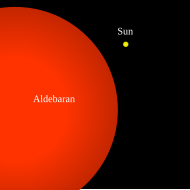
Back بوابة:نجوم Arabic Portail:Étoiles French Portal:Bintang ID Portale:Stelle Italian Portal:Estrelas Portuguese Portal:Stea Romanian Проект:Астрономические объекты/Звёзды Russian Portál:Hviezda Slovak Cổng thông tin:Sao Vietnamese Portal:恒星 Chinese
IntroductionA star is a luminous spheroid of plasma held together by self-gravity. The nearest star to Earth is the Sun. Many other stars are visible to the naked eye at night; their immense distances from Earth make them appear as fixed points of light. The most prominent stars have been categorised into constellations and asterisms, and many of the brightest stars have proper names. Astronomers have assembled star catalogues that identify the known stars and provide standardized stellar designations. The observable universe contains an estimated 1022 to 1024 stars. Only about 4,000 of these stars are visible to the naked eye—all within the Milky Way galaxy. A star's life begins with the gravitational collapse of a gaseous nebula of material largely comprising hydrogen, helium, and trace heavier elements. Its total mass mainly determines its evolution and eventual fate. A star shines for most of its active life due to the thermonuclear fusion of hydrogen into helium in its core. This process releases energy that traverses the star's interior and radiates into outer space. At the end of a star's lifetime as a fusor, its core becomes a stellar remnant: a white dwarf, a neutron star, or—if it is sufficiently massive—a black hole. Stellar nucleosynthesis in stars or their remnants creates almost all naturally occurring chemical elements heavier than lithium. Stellar mass loss or supernova explosions return chemically enriched material to the interstellar medium. These elements are then recycled into new stars. Astronomers can determine stellar properties—including mass, age, metallicity (chemical composition), variability, distance, and motion through space—by carrying out observations of a star's apparent brightness, spectrum, and changes in its position in the sky over time. Stars can form orbital systems with other astronomical objects, as in planetary systems and star systems with two or more stars. When two such stars orbit closely, their gravitational interaction can significantly impact their evolution. Stars can form part of a much larger gravitationally bound structure, such as a star cluster or a galaxy. (Full article...) Selected star - Photo credit: commons:user:Riffsyphon1024 and commons:user:Mysid
Aldebaran (α Tau, α Tauri, Alpha Tauri) is a red giant star located about 65 light years away in the zodiac constellation of Taurus. With an average apparent magnitude of 0.87 it is the brightest star in the constellation and is one of the brightest stars in the nighttime sky. The name Aldebaran is Arabic (الدبران al-dabarān) and translates literally as "the follower", presumably because this bright star appears to follow the Pleiades, or "Seven Sisters" star cluster in the night sky. In 1997 a substellar companion was reported but subsequent observations have not confirmed this claim. Aldebaran is classified as a type K5III star. It is an orange giant star that has moved off the main sequence line of the Hertzsprung–Russell diagram. It has exhausted the hydrogen fuel in its core and hydrogen fusion has ceased there. Although not yet hot enough for fusing helium, the core temperature of the star has greatly increased due to gravitational pressure and the star has expanded to a diameter of 44.2 times the diameter of the Sun,Richichi & Roccatagliata (2005) derived an angular diameter of 20.58±0.03 milliarcsec, which given a distance of 65 light years yields a diameter of 61 million km.</ref> approximately 61 million kilometres (see 10 gigametres for similar sizes). The Hipparcos satellite has measured it as 65.1 light-years (20.0 pc) away, and it shines with 150 times the Sun's luminosity. Aldebaran is a slightly variable star, of the slow irregular variable type LB. It varies by about 0.2 in apparent magnitude. Selected article - Photo credit: NASA/ESA
A binary star is a star system consisting of two stars orbiting around their common center of mass. The brighter star is called the primary and the other is its companion star, comes, or secondary. Research between the early 19th century and today suggests that many stars are part of either binary star systems or star systems with more than two stars, called multiple star systems. The term double star may be used synonymously with binary star, but more generally, a double star may be either a binary star or an optical double star which consists of two stars with no physical connection but which appear close together in the sky as seen from the Earth. A double star may be determined to be optical if its components have sufficiently different proper motions or radial velocities, or if parallax measurements reveal its two components to be at sufficiently different distances from the Earth. Most known double stars have not yet been determined to be either bound binary star systems or optical doubles. Binary star systems are very important in astrophysics because calculations of their orbits allow the masses of their component stars to be directly determined, which in turn allows other stellar parameters, such as radius and density, to be indirectly estimated. This also determines an empirical mass-luminosity relationship (MLR) from which the masses of single stars can be estimated. Binary stars are often detected optically, in which case they are called visual binaries. Many visual binaries have long orbital periods of several centuries or millennia and therefore have orbits which are uncertain or poorly known. They may also be detected by indirect techniques, such as spectroscopy (spectroscopic binaries) or astrometry (astrometric binaries). If a binary star happens to orbit in a plane along our line of sight, its components will eclipse and transit each other; these pairs are called eclipsing binaries, or, as they are detected by their changes in brightness during eclipses and transits, photometric binaries. If components in binary star systems are close enough they can gravitationally distort their mutual outer stellar atmospheres. In some cases, these close binary systems can exchange mass, which may bring their evolution to stages that single stars cannot attain. Examples of binaries are Sirius and Cygnus X-1 (of which one member is probably a black hole). Binary stars are also common as the nuclei of many planetary nebulae, and are the progenitors of both novae and type Ia supernovae. Selected image - Photo credit: Digitized Sky Survey, ESA/ESO/NASA
Orion's Belt or the Belt of Orion is an asterism in the constellation Orion, consisting of the three bright stars Alnitak, Alnilam and Mintaka. The stars are more or less evenly spaced in a straight line, and so can be visualized as the belt of the hunter's clothing. Did you know?
SubcategoriesTo display all subcategories click on the ►
Selected biography - Photo credit: Uploaded by User:Maksim
Hipparchus was born in Nicaea (now Iznik, Turkey), and probably died on the island of Rhodes. He is known to have been a working astronomer at least from 147 to 127 BC. Hipparchus is considered the greatest ancient astronomical observer and, by some, the greatest overall astronomer of antiquity. He was the first whose quantitative and accurate models for the motion of the Sun and Moon survive. For this he certainly made use of the observations and perhaps the mathematical techniques accumulated over centuries by the Chaldeans from Babylonia. He developed trigonometry and constructed trigonometric tables, and he has solved several problems of spherical trigonometry. With his solar and lunar theories and his trigonometry, he may have been the first to develop a reliable method to predict solar eclipses. His other reputed achievements include the discovery of Earth's precession, the compilation of the first comprehensive star catalog of the western world, and possibly the invention of the astrolabe, also of the armillary sphere, which he used during the creation of much of the star catalogue. It would be three centuries before Claudius Ptolemaeus' synthesis of astronomy would supersede the work of Hipparchus; it is heavily dependent on it in many areas. TopicsThings to do
Related portalsAssociated WikimediaThe following Wikimedia Foundation sister projects provide more on this subject:
Discover Wikipedia using portals |
© MMXXIII Rich X Search. We shall prevail. All rights reserved. Rich X Search
























